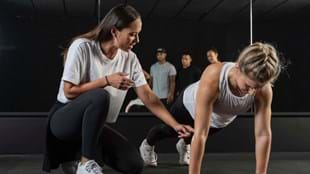As Instructors, we put our bodies through A LOT.
It’s likely we teach more than one program, and we probably teach more than one class a week. Add to this volume: additional classes for covers, our own training, plus the fact that our class schedule is more likely to be dictated by the needs of the club rather than what might be optimal for our bodies… a lot of us are pushing ourselves to the max week in, week out, with little time off for rest and recovery.
The reality is that when we get injured, we don’t like taking time off. We know we should, and we know that continuing to teach with that dodgy shoulder or bad knee isn’t going to be good in the long term… but taking time off means we lose money, we have to find a cover Instructor, and of course we love teaching! We don’t WANT to be missing out on our favorite class of the week, or not seeing our members for a month!
The good news is that when we better understand the contributing factors to injury, we are more likely to stay injury-free and promote longevity in our Instructor careers.
So what are the main causes of injury, and how can we overcome them?
PROBLEM: MUSCLE TIGHTNESS
If you have tight calves you are in good company, almost all Instructors appear to suffer from muscle tightness in our legs! When we exercise, we are constantly demanding contractions from our muscles. This continuous rate of contraction may result in a shortening of the muscle, which in turn can lead to a limited range of motion and may create a muscle imbalance – which can increase our propensity for injury. A limited range of movement at the ankle (dorsiflexion) may inhibit correct form in jumping and squatting – and as Instructors we often perform many of these exercises over the week!
SOLUTION: STRETCHING, MASSAGE, FOAM ROLLING
Ensuring you are regularly stretching your soleus and gastrocnemius (calf muscles) will help with correcting tightness in these muscles. A similar approach to other potential problem areas can also be of value. Stretches for the hip-flexors can also assist to release the psoas – which in turn can help with certain types of lower back pain.
Proprioceptive neuromuscular facilitation (PNF) stretching is a popular, advanced method of deep stretching. It typically involves passively stretching a muscle (or muscle group), then performing an isometric contraction of that muscle, then once again passively stretching that same muscle to achieve a deeper stretch at a greater range of motion.
Foam rolling can also assist with helping the muscle to relax. Read more on the benefits of foam rolling here.
PROBLEM: MUSCLE WEAKNESS
Muscle weakness occurs when our full effort doesn’t produce a normal muscle contraction or movement. Of course, we can experience this at the conclusion of a gruelling workout, when we have simply exhausted ourselves! However, persistent muscle weakness may indicate an underlying muscle imbalance. Stronger muscles can begin to dominate weaker ones, resulting in uneven forces acting on our joints. These imbalances can place excessive strain on joints as we have less control during impact activities or in the way we stabilise our joints when lifting.
SOLUTION: MANUAL MUSCLE TESTING AND STRENGTHENING OR CONSULT YOUR GP
If you believe this to be related to a muscle imbalance, an assessment from a qualified sports practitioner can determine the cause of your muscle weakness and recommend appropriate treatment. In some cases, physical therapy may be helpful.
Manual muscle testing of the affected area may also highlight an asymmetric weakness (one side is weaker than the other). Identifying this makes it possible to realign/balance the body through isolated strengthening on the weaker side.
PROBLEM: OVERTRAINING AND OVERUSE
The most obvious problem of all! We do too much, with too little rest in between sessions. Symptoms include:
- Excessive fatigue
- Troubled sleep
- Inability to concentrate
- Inability to perform exercises with correct technique.
A physiological sign of overtraining is also an increased resting heart rate.
Overuse injuries are caused by repeated actions that apply pressure to a certain group of muscles, joint or area of soft tissue. Symptoms include a gradual pain which worsens over time, sometimes accompanied by swelling and/or bruising.
SOLUTION: REVIEW YOUR TEACHING SCHEDULE AND ENSURE YOU’RE MIXING IT UP
The best way to avoid overtraining and overuse is to ensure adequate rest between sessions – so look at your schedule and see what you can move around. If you’re doing a lot of one type of class – weight training, high impact, or HIIT – consider training to teach different types of programs or using LES MILLS On Demand to mix your training up.
Have a look at this article on a study we conducted on the type of injuries encountered by Les Mills Group fitness Instructors. By varying our training we can avoid a lot of these injuries, plus ensure we’re not getting too much repetitive loading through our teaching and training.
So what else can we do?
INCLUDE CXWORX™ IN OUR TRAINING REGIME
If you don’t teach or participate in CXWORX, you are missing out on the most accessible program to ensure you stay injury-free. All of the exercises in this 30-minute format are designed to improve our functional core strength and movement control.
DON’T TEACH WHEN INJURED
As tempting as it can be to “just push through” – don’t. You want to be able to keep teaching for many years to come and one of the surest ways to jeopardize your future classes is to exercise when your body is telling you to rest. Yes, you might lose out on some money in the short term and your members will miss you, but isn’t it worth taking a few classes off and getting better than risking not being able to teach for the rest of the year?
Steve Tansey is the UK Programme Specialist and International Presenter for BODYCOMBAT™, Senior Trainer and Presenter for LES MILLS GRIT™ with 18 years teaching Les Mills classes. He has a Master’s Degree in Strength and Conditioning and 22 years mixed martial arts experience. He is also the Head of Research and Development in the UK and a Regional Training Coordinator responsible for Instructor engagement.







